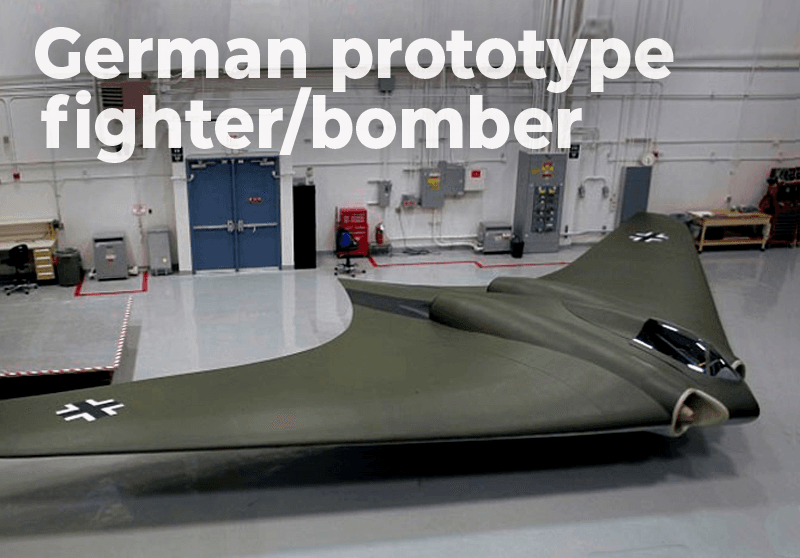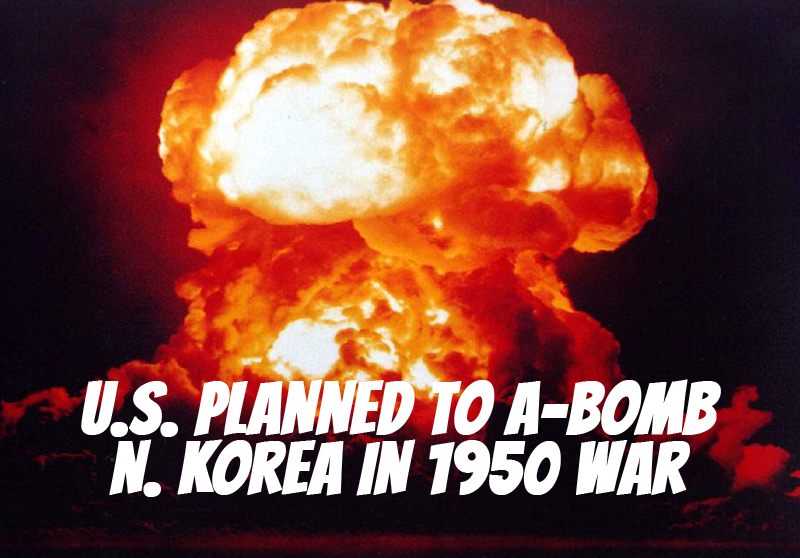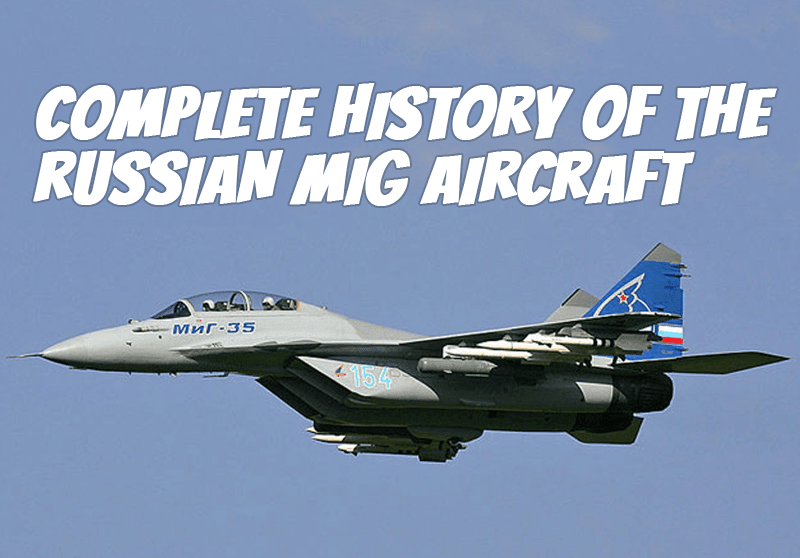With their speed of more than 200 MPH faster our losses were unacceptable
This article is certainly not meant to glorify the German Air Force, but to show you many photos of aircraft you may not have seen before. Along with the photos will be specifications and comments. The German aircraft did have many innovative designs that have stirred the minds of history buffs and aviation enthusiasts. Before I begin I would like to point out it was fortunate for us that the USAF cleared the skies of their aircraft. If given enough time to produce large amounts of these aircraft the outcome would have been too close for comfort. I believe any military strategist will agree that Germany was more of a danger to the entire world than we would like to admit. We are indeed fortunate that Adolf Hitler continuously made the mistakes he made.
Hitler was responsible for making decisions that either slowed or completely stopped many extremely important projects. Germany had the scientists capable of finalizing the production of a nuclear bomb. They had progressed to the point of where they were close to putting it all together. Wernher von Bruan had developed an awesome ballistic missile in the V-2 bomb. If given time we all agree he had the capability of producing a nuclear warhead which could have been attached to a perfected V-2 that could have reached the U.S. Once again we were lucky the U.S. rushed him to our country, along with other German scientist, to work on our many developing projects. We now know his capability as he solved many of our problems such as working on the Manhattan project. The V-1 Buzz bomb was an extremely dangerous weapon that did horrible damage to the civilian population of Britain. The Germans were also blessed with such an aeronautical genius as Messerschmitt. Even the auto by Mercedes was a piece of art. The aircraft they developed before anyone else were much faster. Even today the German Luger is a real collectors item. So if all this is true, then what happened? Massive American production of military hardware happened. We produced the B-24, the B-17, and the P-51 by the thousands. We continuously dropped tons of bombs on specific targets every day until we destroyed all manufacturing plants and completely shut down the entire German Air Force, not to mention the complete destruction of every building in every city.
This article will feature many photos of interesting aircraft along with specifications.
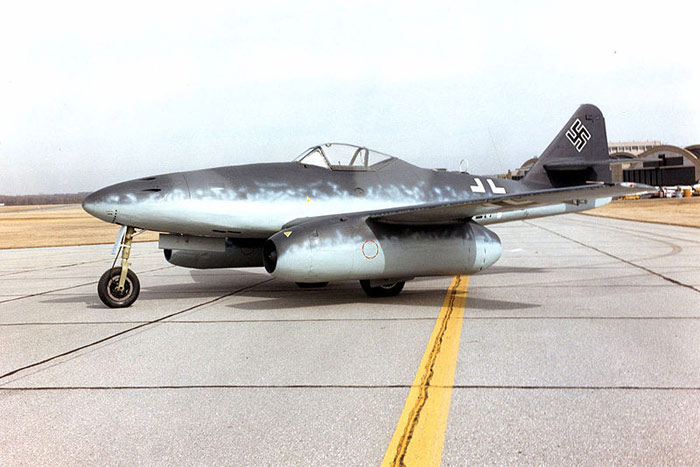
ME-262
The ME-262 was the worlds first operational fighter. With two turbojets it had a speed of 540 MPH, and an altitude capability of 37,500 feet. Manufactured by Messerschmitt it was faster than any allied aircraft by 200 MPH. It had a slow start due to Hitler. He wanted a bomber, not a fighter. After his objections they hung two 500 pound bombs under it. He said “that’s only a fighter with a couple of bombs.” In Aug, 1939, one week before the beginning of WWII, a German aircraft made the first jet-powered flight in history. It was two years before the British or American flights. Again Hitler stalled production and ordered only a few initial prototypes. Feb. 1944- allied bombing of the ME factories delayed production another few months. April 1944- the first production planes were destroyed by bombing. In Sept. 1944, the Luftwaffe’s 60 ME 262s were destroyed on the ground by allied bombers. In March 1945 the German jet fighter wing shot down six American bombers and two fighters, and lost only one 262. March 45- In the last big air combat over Germany, Berlin was bombed by 1200 American bombers escorted by fighters. Although greatly outnumbered the 262s shot down 25 bombers and 5 fighters.
The next month 30mm cannons were added plus 50mm air to air rockets. Adolph Galland scored 103 victories, mostly due to the added armament. Overall over 1400 ME-262s were produced, but due to lack of fuel less than 100 were available at any one time. The top German ace was Heinz Baer with 220 victories, scoring 16 of these with the ME -262.
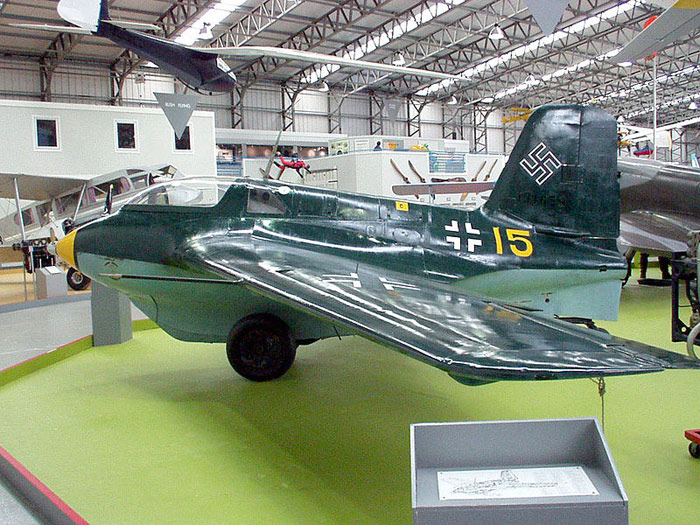
ME-163
The rocket powered ME-163 Komet is the only rocket-powered fighter aircraft to have ever been operational. It’s design was revolutionary, and the plane was capable of performance unequaled at the time. In 1944 it reached 698 MPH. Over 300 were built, however it proved ineffective as a fighter. It was powered by a liquid-fuel rocket. It had a very limited flying time of only seven and a half minutes, and a range of only 25 miles- seriously damaging it’s capability. It was armed with two 30mm MK-108 cannons. Only 10 remain today in museums. The Komet did not have a landing gear. The two wheels mounted on each side of the landing skid, were released on takeoff, many times bouncing up and striking the aircraft. For landing it actually landed on the skid, resulting in a rough and dangerous landing. Many exploded just sitting on the ramp, and fueling proved to be a job everyone feared. Fueling the Komet was actually like a suicide mission.
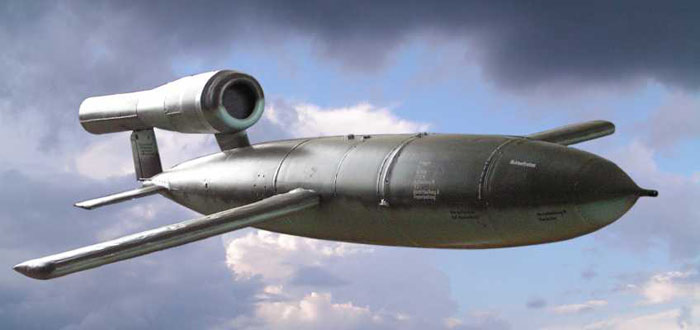
V-1
The German V-1 “flying bomb” was actually an early cruise missile. It was developed by the Luftwaffe between June 44 and March 45. The purpose was to have it hit population centers in London. It was powered by a pulse jet engine. Speed was close to 400 mph, and a range of 150 miles. The bomb could not take off on it’s own and required a catapult or air-launch from a HE-111. The guidance system employed a somewhat sophisticated automatic pilot, a weighted pendulum system, a gyrocompass, and a radio transmitter for flight direction. An odometer driven by a vane anemometer on the nose determined when the target had been reached. The bomb then set off a complicated cut -off system putting it into a steep dive. About 15 to 18 a day could be launched. 30,000 V-1s were made, with 10,000 fired at England. 2,419 reached London killing over 6,000 and injuring 18,000. Over 4,261 were destroyed by fighters, and heavy bombing of the launch site.
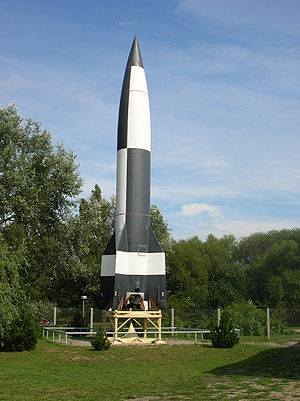
V-2 BOMB
The V-2 bomb, developed by Wernher von Braun, was a long range ballistic missile that was completed just before the end of WWII. The V-2 was the world’s first long range combat-ballistic missile and the first to achieve sub-orbital space flight. It was the influence of all modern rockets. Over 3,000 V-2s were launched as military rockets by the German Wehrmacht against allied targets in WWII, mostly London and later Antwerp, resulting in the death of an estimated 7,250 military personnel and civilians.
An estimated 20,000 inmates at the manufacturing plant died constructing the V-2. Of these 9,000 died from exhaustion and collapse, 350 were hanged, including 200 executed for acts of sabotage, and the remainder were either shot or died from disease or starvation. The rocket had large liquid-fuel engines, supersonic aerodynamics, gyroscopic guidance and rudders for control. Hitler, not impressed, pointed out that it was merely an artillery shell with longer range and higher cost. An average of 10 V-2s launched per day and over 1,000 per month as the supply allowed.
The V-2 program was the single most expensive development project of the Third Reich. 6,048 were built, 3,225 were launched. Concentration camp prisoners were used as slave laborers, and the entire project had a reputation of brutality. The V-2 is probably the only weapon system to have caused more deaths by it’s production than it’s deployment.
A submarine-towed launch platform was tested successfully, which would have allowed a U-boat to launch missiles against the U.S. Work on the Atomic Bomb, if completed and adapted to the V-2, would have caused havoc in the U.S. With the atomic warhead attached the outcome could have been devastating.
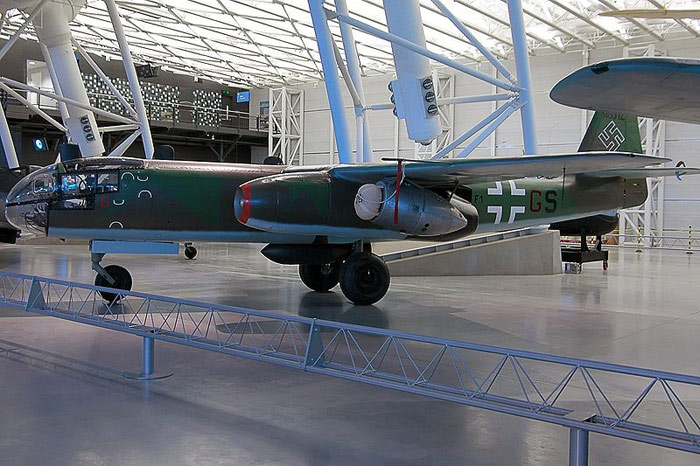
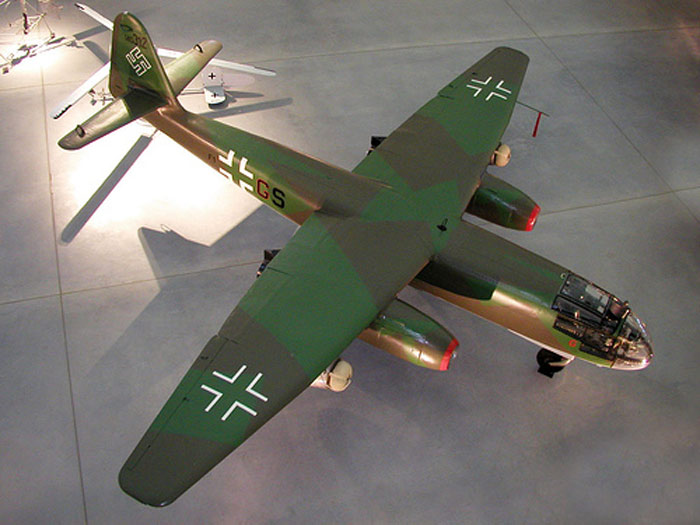
ARADO-234-B-2
The Smithsonian took five years to restore this aircraft, and it became one of the first aircraft moved to the Steven F. Udvar-Hazy Center near Dulles International Airport. It is displayed next to the only surviving Dornier Do 335. Maximum speed was 461 mph with a service ceiling of 32,800 feet. The AR-234-C was equipped with four BMW 003A engines mounted in a pair of twin engine nacelles. The C-1 was a four engine version of the AR-234-B-1, and the C-2 was a four engine version of the B-2. The Arado 234 was the world’s first operational jet powered bomber. Remember the ME-262 was a fighter. The Arado was built in the closing months of the war. The Arado-234 at the Smithsonian is the only one in existence today. SEE THE PHOTO AT END OF ARTICLE OF AN ARADO 234 C-2
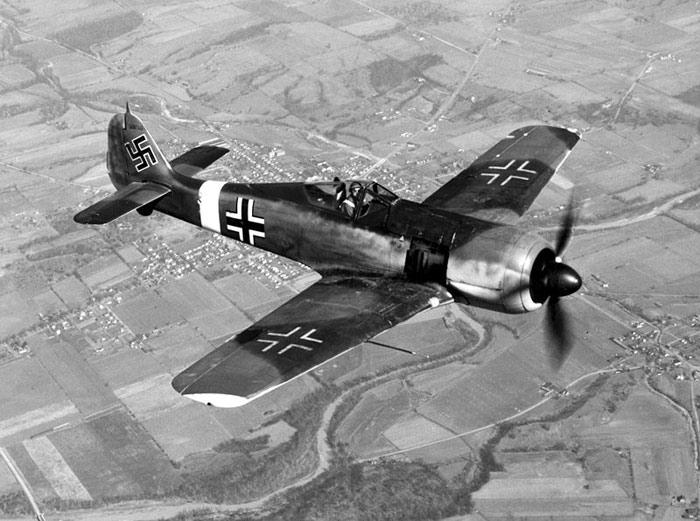
FOCKE-WULF FW-190
The German single seat fighter was the last mass produced aircraft to see action in WWII. Some of the Luftwaffe’s most successful fighter aces flew the FW-190, including Otto Kittel with 267 victories, Walter Nowotny with 258 victories, and Erich Rudorffer with 222 kills. Maximum speed of this aircraft was 408 mph.
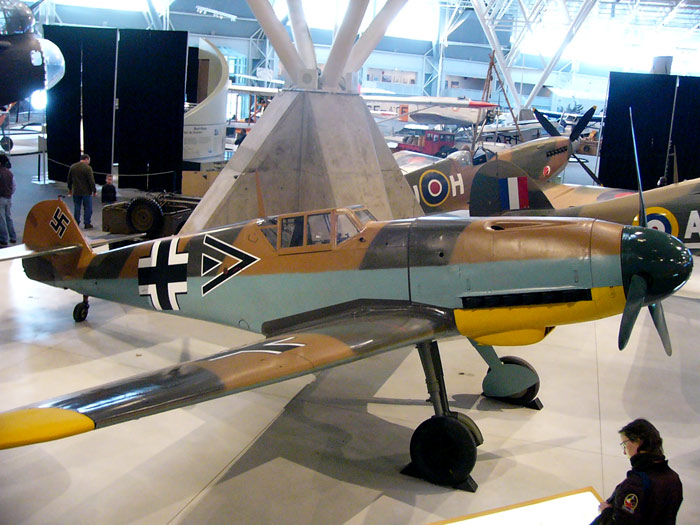
ME-109F
The ME-109F was the backbone of the entire German Luftwaffe fighter force. It was the most produced warplane of WWII, with over 30,573 built during the war. It was the most produced fighter aircraft in history with a total of 33,984 units produced up to April 1945. Three top-scoring German aces claimed 928 victories with this aircraft. Maximum speed reported at 400 mph, ceiling at 39,370 feet.
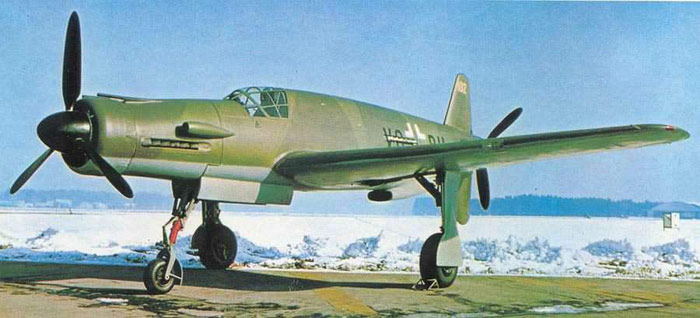
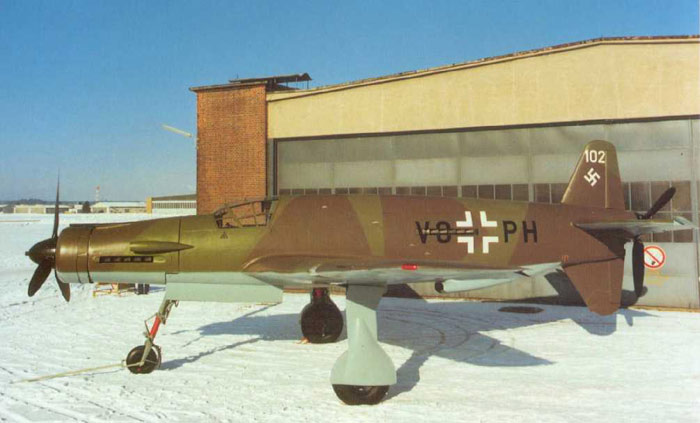
DO-335
This aircraft is not only the most unusual, but is the only one in existence today. It belongs to the NASM at Washington and is stored at the Garber facility. It was the fastest German piston engine plane in WWII. No allied fighter was able to reach it’s speed up until the end of the war. Top speed was 474 mph with a ceiling of 37,400 feet. It was armed with one 30mm cannon and two 20 mm cannons. The interesting push-pull arrangement is somewhat unique. This plane was returned to the Dornier Plant in Germany for restoration. Many workers restoring the aircraft had worked on the plane originally.
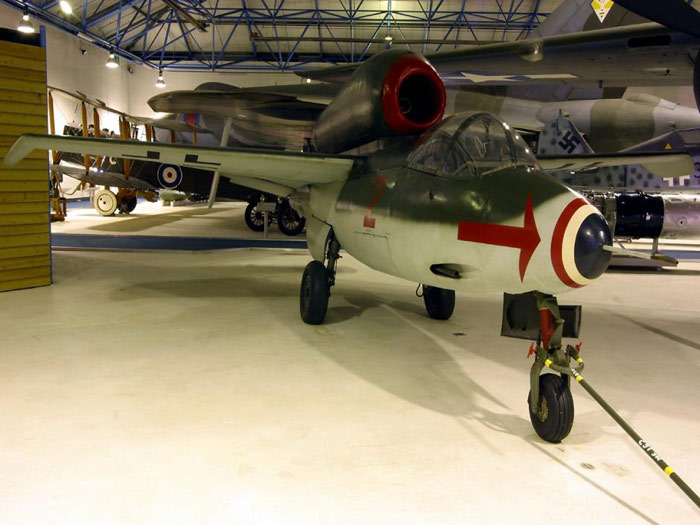
HEINKEL HE-162
The HE-162 was a single engine jet powered fighter aircraft. To build it quickly it was constructed primarily of wood as metals were in short supply. 170 were built for the Luftwaffe. The aircraft at that time was one of the fasted jets with a speed of 562 mph.
Only eight survive at museums. It carried 2 20mm MG-151 cannons and 2 MK-108 30mm cannons.
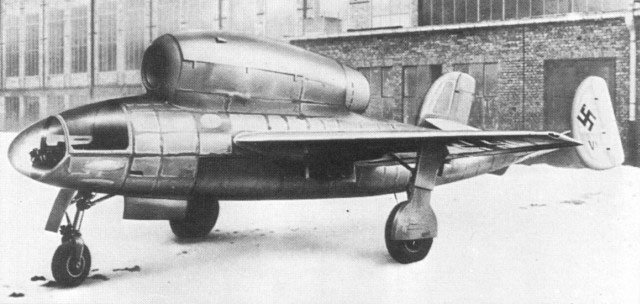
HS-132
The HS-132 was a WWII dive bomber and interceptor for the Luftwaffe that never saw service. The basic model carried one 500kg bomb, reached a speed of 565 mph. It was stressed for a 12g pullout, with the pilot in the prone position. The aircraft was operative but Russian forces captured the production facility.
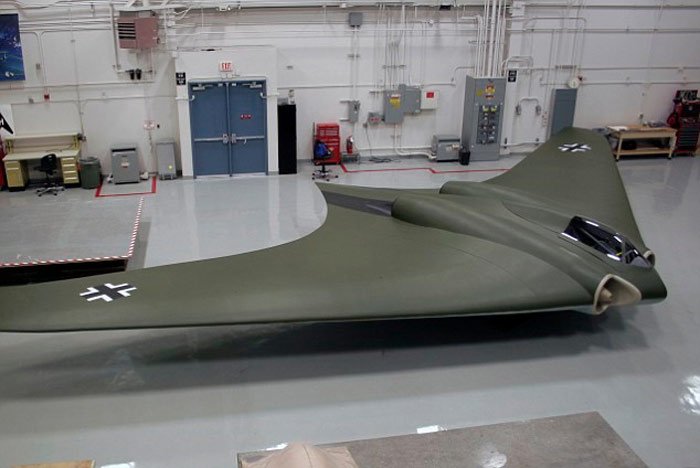
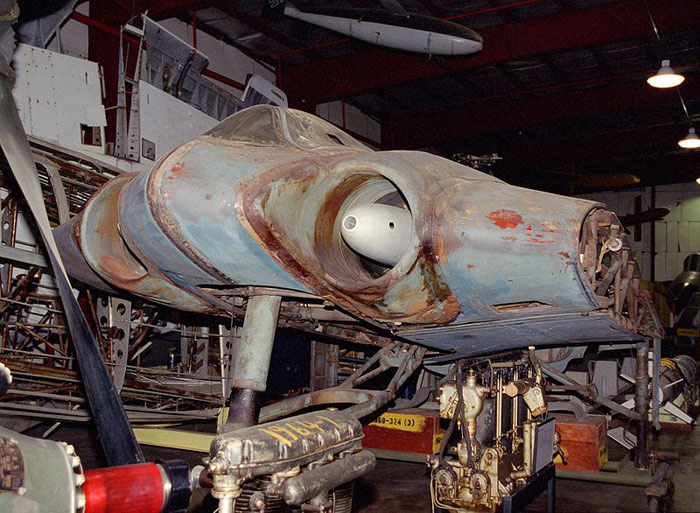
HORTON HO-229
The HO-229 was a late WWII prototype flying wing fighter bomber, powered by a turbojet. Perhaps the first aircraft to use stealth technology. Estimated speed was 636 mph, with an estimated ceiling of 49,213 feet. First flight was march 1, 1944. German production was underway, and a simulated “dog fight” with a ME 262 showed the HO-229 outperformed the ME-262. The only surviving HO-229, the V3, is being restored at the Smithsonian facility. Five completed aircraft found by U.S. soldiers were destroyed to prevent capture by the Russians.
PISTON ENGINED AIRCRAFT OF INTEREST
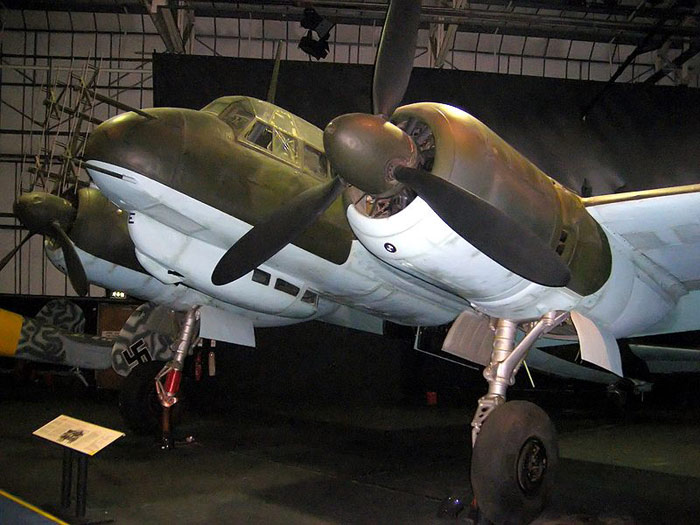
JUNKERS JU-88 BOMBER
The JU-88 was a twin engine , multi-role aircraft, and became one of the most versatile combat aircraft of the war. It was successful as a bomber, dive bomber, night fighter, torpedo bomber, reconnaissance aircraft, and heavy fighter. More than 15,000 were built.
Speed was reported at 280 mph.
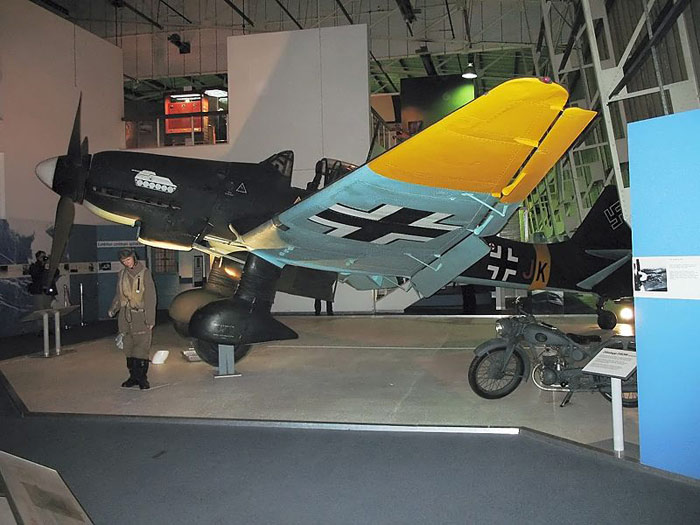
STUKA JU-87 DIVE BOMBER
The Stuka was a two seat dive bomber carrying a rear gunner, first flown in1935. Over 6,500 were built. It actually was an easy target for Allied aircraft. It was powered by the British Rolls-Royce power-plant. Speed was a surprisingly slow 211 mph, however the dive speed was 373. The pilots of the Stuka had to be hand picked as the tremendous G-forces in pullout required a special capability. The stress on the crew was severe. Pilots in a seated position suffered more than 5 Gs which caused vision impairment. After 5 seconds it would result in blackout. Test show the highest load a pilot could endure was 8.5 Gs for 3 seconds when the aircraft was pushed to the limit.
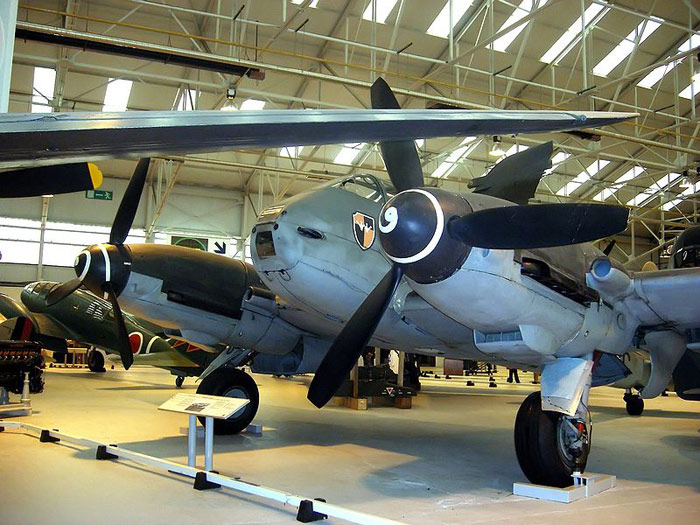
ME-410 A-1
The Me-410 A-1 was a two man night fighter. It had formidable fire power with two additional 20mm cannons in the weapons bay, and four underwing tubes firing 21cm mortar rockets. Many carried the 50mm cannon. With a speed of 388 mph it had an excellent range of 1,400 miles. Over 1,200 were built. At the time it had problems, as all German planes had, with swarms of P-47s and P-51s.
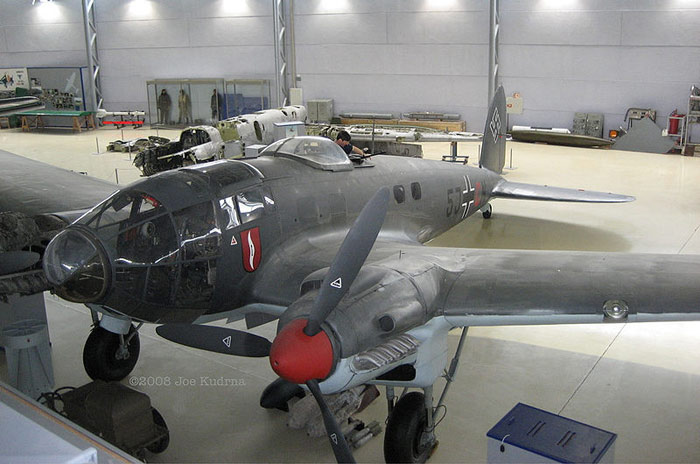
HEINKEL-111P
The Heinkel-111P had arange of 1429 miles, a speed of 273 mph. It was a fast medium bomber. 6,508 were built, with the first flight in 1935
AIR WAR WITH THE U.S. FINISHED THE GERMAN AF
It is somewhat frightening to analyze the formidable array of all the exotic German aircraft. How could our planes compete with the German planes sometimes 200mph faster than ours. Due to Hitlers interference and lack of military intelligence slowed the development of many critical projects. His invasion of Russia was the final blow.
Now comes the B-17s and B-24s by the thousands. Many hundreds every day dropped thousands of tons of bombs on the factories producing these aircraft. Every German city was virtually destroyed. Don’t forget the British effort .When the Russians entered Germany the onslaught was complete. Without their production capabilities the war was over. If they had produced this vast array of equipment earlier the war might have been a little different, however the outcome would have been the same. I give credit to the B-17 and the B-24 for knocking out the German factories producing these planes. They have been beautifully restored and make nice museum pieces.
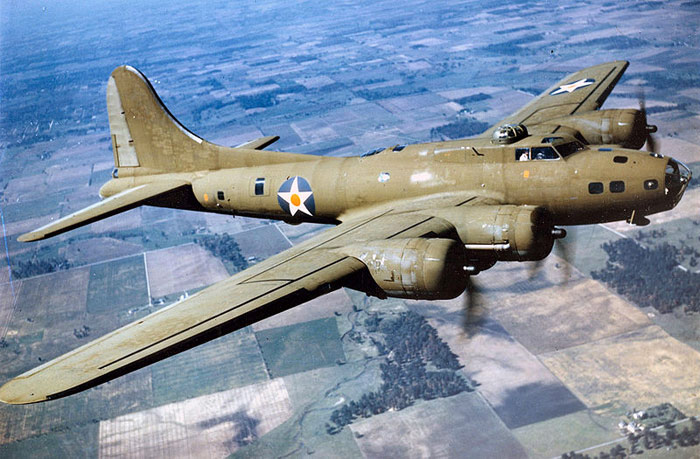
B-17E FLYING FORTRESS
The B-17 began operations with the RAF in 1941. They dropped more bombs than any other aircraft in WWII. Of the 1.5 million tons of bombs dropped on Germany by U.S. aircraft 640,000 tons were dropped from B-17s. On their very first raid 17 Aug. 1943, 230 B-17s were intercepted by 300 Luftwaffe fighters. 36 B-17s were shot down with the loss of 200 men. Coupled with a raid earlier in the day, 60 B-17s were lost in one day.
On 14 Oct. 1943, which would become known as “Black Thursday”, of the 291 B-17s involved in a raid 59 were shot down. Combined with battle damage, and crash landings, a total of 77 were shot down and 122 damaged. Of the 2,900 men in the crews, 650 did not return. Of the damaged aircraft that made it home five men were killed, 43 wounded, and 594 missing action. Only 33 aircraft of the original 291 only 33 returned without damage. Heavy losses were contributed to concentrated attacks by over 300 German fighters. The 8th AF alone lost 176 bombers in the month of Oct. 1943.On 11 Jan. 1944, 60 B-17s were destroyed. Perhaps the most famous B-17, the Memphis Belle, is being restored to it’s wartime appearance at the National Museum of the USAF in Dayton ,Ohio. Over 12,731 B-17s were built by Boeing.
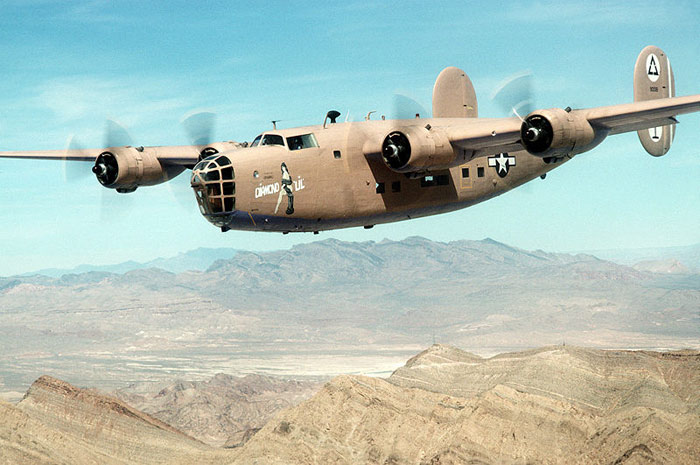
B-24 BOMBER
The B-24 was produced by Consolidated, and 18,188 “Liberators” were made. The Willow Run plant in Detroit, Michigan employed 42,000 workers who produced 8,600 Liberators. Typical mission losses: 178 B-24s took off from Benghazi. 16 aborted or crashed, 162 reached targets around Ploesti. 51 were shot down, 22 had to land at various Allied bases. 89 of the 162 returned to Benghazi with 58 damaged beyond repair
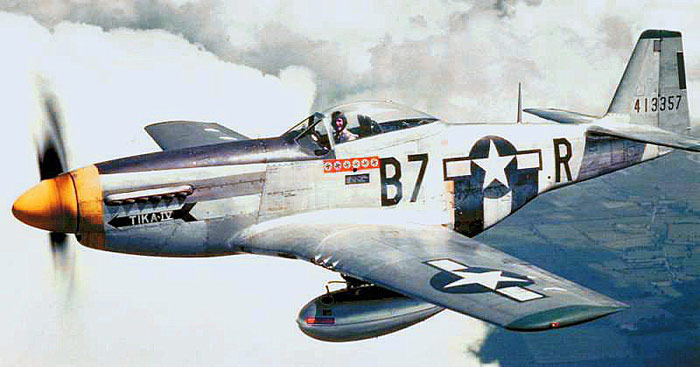
P-51 MUSTANG
The North American Aviation P-51 was a long range fighter, designed, built, and flying in 117 days. It was used as a bomber escort in WWII. It remained in service until the early 80s. The Mustang was fast, well made, and highly durable. It was powered by a Packard V-1650, with a two-stage two speed supercharged engine, and armed with six 50 caliber machine guns. The P-51, using the new V-1650-9 engine made it one of the fastest propeller fighters ever, at 487 mph, with an altitude of 40,000 feet, and a range of 1300 miles. Later Mustangs used different engines and modified bodies. Over 14,819 were built for the Army. 2,520 were lost. Our bombers were suffering unacceptable losses as we went further into Germany. They badly needed long range escorts, and the P-51 solved the problem.
The Americans won the war with Germany and Japan, but at a terrible price. We lost thousands of our best men all because the two countries decided to take over the world. WWI was the “war to end all wars.” Then what was WWII? Are we ready for it to happen again? The truth is that we are not anywhere near ready. We have grown very complacent.
Perhaps it is time we elect people who will not let this happen again.
I happened to be in Luxembourg and wanted to visit the military cemetery and pay my respects to General George Patton. The cemetery is huge, and beautiful. As I stood next to Patton’s grave, I looked at the thousands of white crosses. The air was so thick I could hardly breathe. The very sight of what those crosses meant really choked me up. Each individual grave holding one of America’s finest, to remain the same age forever. I cannot accept that WWII was worth losing even one man. Nor was Korea or Vietnam.
GERMAN LOSSES
The German Army, reported at 18 million soldiers served in WWII. About one million served as SS troops. About 1.3 million Wehrmacht soldiers were killed in action. Two million were missing in action and unaccounted for after the war. A total of 5,533,000 German soldiers were killed or missing in action in WWII. The number of wounded surpassed 6,000,000, and the number of prisoners unknown but in the millions.
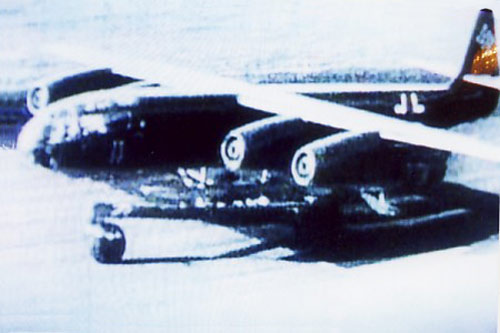
ARADO 234 C-2
As a pilot, aircraft enthusiast, collector of aircraft photos, I have never seen a photo of a C-2 with four individual engine nacelles. Yes, this photo is pretty bad, but I took it from a German movie film strip featuring the roll out of this plane. I have never seen a photo of the supposedly Arado 234 C-2.
- The Battle of Midway: Turning the Tide in the Pacific - June 7, 2023
- The D-Day Operation of June 6, 1944 - June 6, 2023
- The B-29 that Changed History - June 4, 2023

